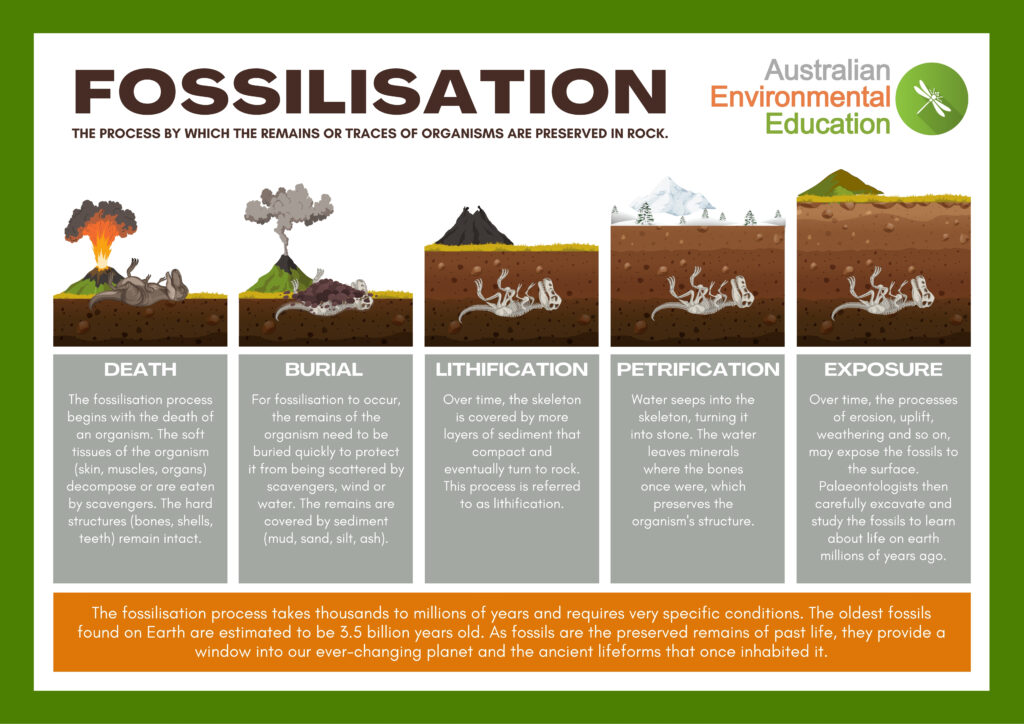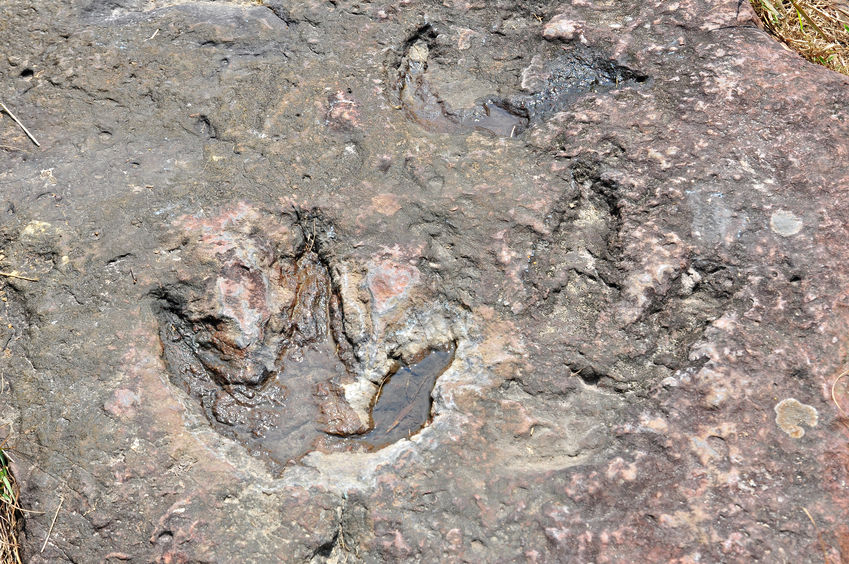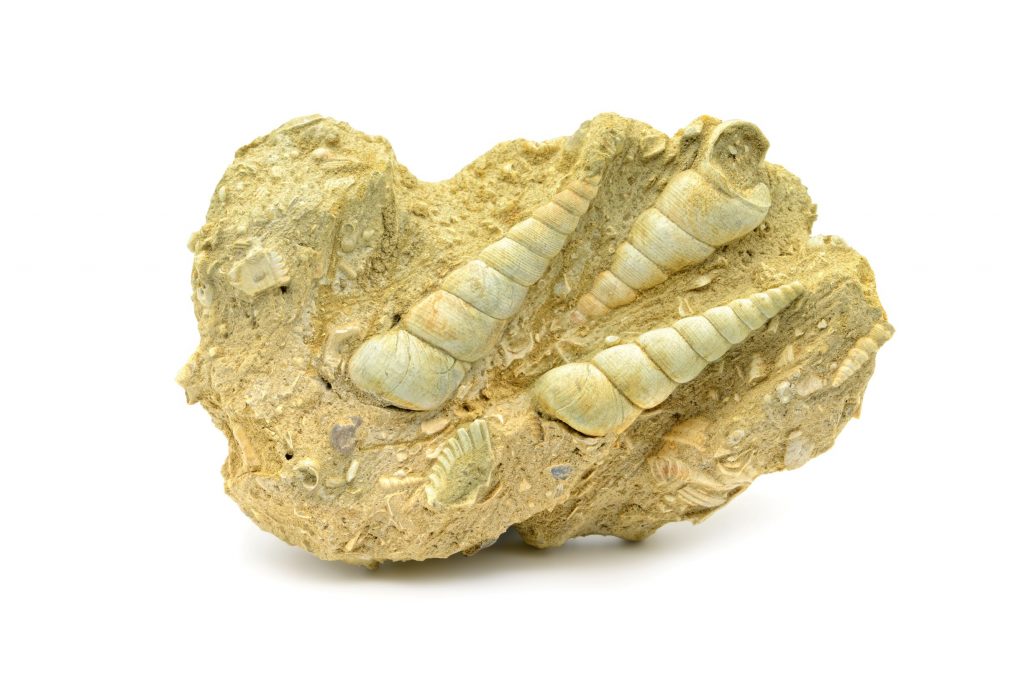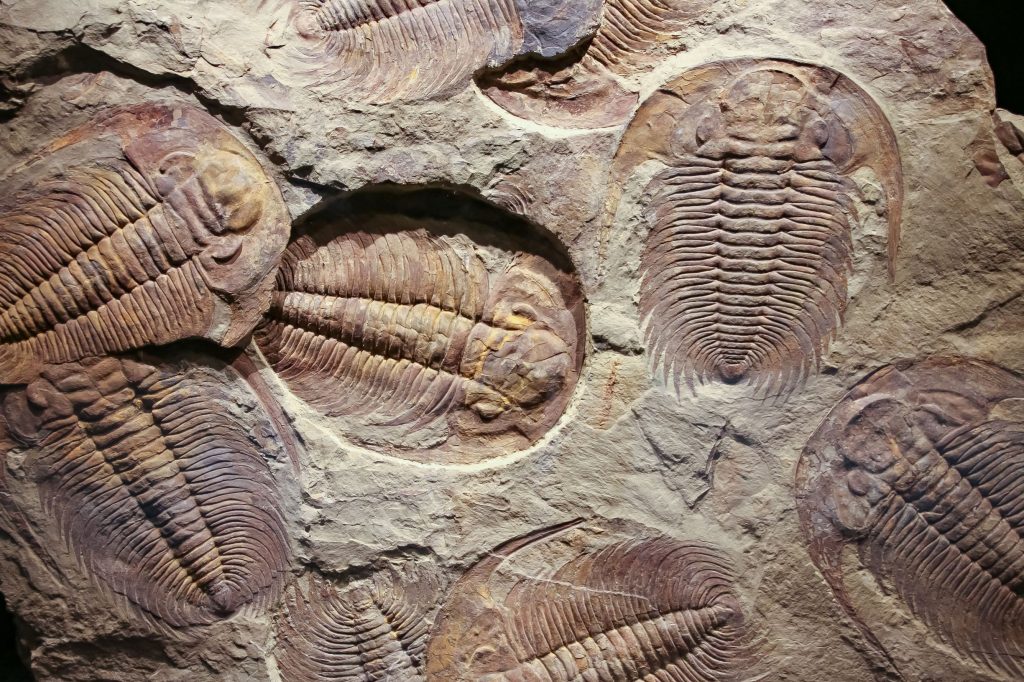Fossils are our window into the past. The word ‘fossil’ comes from the Latin word fossus, which means ‘dug up’. This refers to the fact that fossils are the remains of past life preserved in rock, soil or amber. Generally, the remains were once the hard parts of an organism, such as bones and shell although, under exceptional circumstances, soft tissues have also fossilised.

Trace fossils
Trace fossils are the preserved evidence of an animal’s activity or behaviour, rather than the remains of the animal itself. Examples of trace fossils that have been found include:
- animal tracks
- burrows
- coprolites, fossilised poo

Coprolites
Coprolites are fossilised poo and one of the most common types of trace fossils. They provide evidence for the animal’s behaviour and what ancient ecosystems were like.
Mineralised fossils
These fossils are formed when organic matter in remains is gradually replaced with minerals, ultimately turning the remains to ‘rock’. Types of replacement include:
- Replacement
of organic material in bone with minerals - Replacement
of shell with pyrite - Replacement
of shell with opal - Replacement
of wood with silica – petrified wood

Impression fossils
Fossils can also form when the remains decay completely but leave an impression in the sediment. Impressions can be of the external shape or internal space (which may fill with other minerals or sediment).Examples include internal impressions of trilobites or ammonites and external impressions of armoured fishes or tree bark.

The word ‘palaeontology’ refers to the study of ancient life, with the fossil record forming the basis of this science.
Gastroliths
Gastroliths means “stomach stones”. Stones are swallowed by birds and reptiles, but they can also be found in earthworms, some fish, amphibians, seals and toothed whales. There is evidence that herbivorous dinosaurs swallowed stones to break down their tough food. The gastroliths are sometimes found with their fossilised remains.
Indicator Fossils
Index fossils are fossils used to define and identify geologic periods. Index fossils must have a short vertical range, wide geographic distribution and rapid evolutionary trends. Commonly use species are trilobites and ammonites.
Trilobites
Trilobites form one of the earliest-known groups of arthropods. The first appearance of trilobites in the fossil record in the Early Cambrian period (521 million years ago), and they flourished throughout the lower Paleozoic before slipping into a long decline, when, during the Devonian, all trilobite orders except the Proetids died out. The last extant trilobites finally disappeared in the mass extinction at the end of the Permian about 252 million years ago. Trilobites were among the most successful of all early animals, existing in oceans for almost 300 million years


Ammonites

Ammonites are the extinct relatives of sea creatures such as the modern Nautilus from Palau. Ammonites lived during the periods of Earth history known as the Jurassic and Cretaceous. Together, these represent a time interval of about 140 million years. The Jurassic Period began about 201 million years ago, and the Cretaceous ended about 66 million years ago. The ammonites became extinct at the end of the Cretaceous Period, at roughly the same time as the dinosaurs disappeared. However, we know a lot about them because they are commonly found as fossils, formed when the remains or traces of the animal became buried sediment that later solidified into rock.

Ammonites: the geologists’ time marker. The use of ammonites in stratigraphy was pioneered in the 1850s by two Germans — Friedrich Quenstedt of Tübingen (1809–1889) and his one-time pupil, Albert Oppel of Munich (1831–1865).
Their work was based on the ammonites of the Swabian and Franconian Alb of southern Germany — the eastern extension of the Jura Mountains of France and Switzerland, from which the Jurassic Period takes its name.
Ammonites make excellent guide fossils for stratigraphy because:
- they evolved rapidly so that each ammonite species has a relatively short life span
- they are found in many types of marine sedimentary rocks
- they are relatively common and reasonably easy to identify
- they have a worldwide geographical distribution
Ammonites can be used to distinguish intervals of geological time of less than 200 000 years duration. In terms of Earth history, this is very precise
The rapidity of ammonite evolution is the single most important reason for their superiority over other fossils for the purposes of correlation. Such correlation can be on a worldwide scale.
Find out whats new for you and your students with the latest Blogs from Sydney Science Education
- Where are all the Christmas beetles?
- Dive in and care for our coasts
- Celebrate FrogID Week 2025: Tune into Nature’s Chorus
- Celebrating 7 Years of Australian Environmental Education
- Biodiversity Month 2025 – Every Species Matters
Follow Sydney Science Education on Facebook

